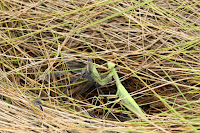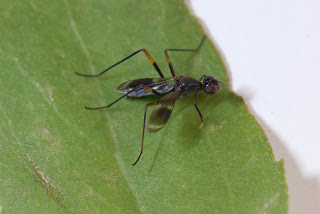The last wild frontier - the salt marsh, and the creatures that call it home
Sep 3, 2012
A damsel bug
Damsel bugs (family Nabidae) are slender creatures resembling miniature praying mantids in having raptorial front legs. Like praying mantids, their front legs are used to capture small prey, likely plant hoppers on the salt marsh. Damsel bugs have a long beak with which they suck out juices from insects they capture. The beak can also delivery a painful bite, if handled carelessly. These individuals are possibly nymphs, i.e immature true bugs since they don't have fully developed wings.
Aug 13, 2012
August - the battle of two predators 2
Praying or European mantis (Mantis religiosa) is the most
common mantid on the salt marsh. As the name suggests, it is an introduced
species that came to the US
Aug 3, 2012
Parasitoids - the truely tiny
Parasitoids, or insect consuming other insect but in moderation (usually just one) are frequently overlooked due to their small size, like a flying spec of dust. These tiny wasps search for eggs or small insects as a food source for their larvae.
End of July - The battle of two predators 1
Seaside dragonlet is among the most beautiful insects on the salt marsh. It is also among its deadliest. As an immature, which is called naiad for dragonflies, it is the top invertebrate predator in the potholes and on the mudflats, a hunter of other creatures.
As an adult, seaside dragonlet eats whatever it can catch, mostly flies - mosquitoes, midges, syrphids and similar. But, the marsh surface is also a home to another deadly creature, the spider. Spiders are mostly generalist predators and take whatever comes their way, which usually means the most abundant insects at the moment. This year it's been dragonflies buzzing around in enormous swarms. Sadly, many ended up in the spider nets protruding from the salt marsh vegetation...
As an adult, seaside dragonlet eats whatever it can catch, mostly flies - mosquitoes, midges, syrphids and similar. But, the marsh surface is also a home to another deadly creature, the spider. Spiders are mostly generalist predators and take whatever comes their way, which usually means the most abundant insects at the moment. This year it's been dragonflies buzzing around in enormous swarms. Sadly, many ended up in the spider nets protruding from the salt marsh vegetation...
Jul 23, 2012
More July plant eaters - and predators
This gem of a true bug (Trigonotylus uhleri) from the family Miridae or aptly named Plant Bugs is a common denizen of the salt marsh. It apparently really likes the saltmarsh cordgrass (Spartina alterniflora) sucking out the juice with the stylet like mouth. The young look like miniature adults with reduced wings.The striped coloration resembles some of the planthoppers, distant cousins of these plant bugs.
Yet to be identified beetles were happily munching on the salt marsh threesquare (Schoenoplectus robustus) leaves. Interestingly, there were two color forms, one with mostly brown elytra (wing cover) color, and another with almost black, with some intermediate forms present as well, perhaps sexual dimorphism or even two different species?
 This beauty is only visiting the salt marsh from nearby freshwater ponds. A slender and fragile dragonfly relative, the Bluet damselflies (genus Enallagma) are also predators. This particular individual seemed to hover around salt marsh hay grass and pick out tiny bugs possibly planthoppers (?). The immature Bluets, called naiads, live in ponds and feed on small water creatures.
This beauty is only visiting the salt marsh from nearby freshwater ponds. A slender and fragile dragonfly relative, the Bluet damselflies (genus Enallagma) are also predators. This particular individual seemed to hover around salt marsh hay grass and pick out tiny bugs possibly planthoppers (?). The immature Bluets, called naiads, live in ponds and feed on small water creatures.
Yet to be identified beetles were happily munching on the salt marsh threesquare (Schoenoplectus robustus) leaves. Interestingly, there were two color forms, one with mostly brown elytra (wing cover) color, and another with almost black, with some intermediate forms present as well, perhaps sexual dimorphism or even two different species?
 This beauty is only visiting the salt marsh from nearby freshwater ponds. A slender and fragile dragonfly relative, the Bluet damselflies (genus Enallagma) are also predators. This particular individual seemed to hover around salt marsh hay grass and pick out tiny bugs possibly planthoppers (?). The immature Bluets, called naiads, live in ponds and feed on small water creatures.
This beauty is only visiting the salt marsh from nearby freshwater ponds. A slender and fragile dragonfly relative, the Bluet damselflies (genus Enallagma) are also predators. This particular individual seemed to hover around salt marsh hay grass and pick out tiny bugs possibly planthoppers (?). The immature Bluets, called naiads, live in ponds and feed on small water creatures.Jul 14, 2012
July is for plant munching
July is a good month for herbivores. The marsh vegetation is vigorous but not yet toughened and scorched by the heat. It is also tall and dense, with many nooks and crannies to hide and be invisible. Grasshoppers have chewing mouthparts, and love to munch on the threesquare (Schoenoplectus pungens). Despite their relatively large size, the salt marsh grasshoppers are a wary bunch always preferring to keep a leaf blade between them and a potential danger jumping off or dropping to the ground at the slightest movement.
Salt marsh lacks large mammalian herbivores, there are no herds of buffalo or antelopes. Even grasshopper sized insects are not the plant eaters dominating Spartina prairie. The main herbivores are tiny sapsuckers, leafhoppers and planthoppers swarming the grasses this time of the year. More on those later on.....
Salt marsh lacks large mammalian herbivores, there are no herds of buffalo or antelopes. Even grasshopper sized insects are not the plant eaters dominating Spartina prairie. The main herbivores are tiny sapsuckers, leafhoppers and planthoppers swarming the grasses this time of the year. More on those later on.....
The aphid eaters
The larvae of a green lacewing (Neuroptera) are voracious predators. Often, they go after prey twice their size. On salt marsh, these little fierce creatures with outsized scythe like jaws are common on the marsh elder (Iva frutescens).
The green lacewing larvae run busily up and down the branches inspecting the leaves for aphids. When found, an aphid is grabbed forcefully without hesitation and no resistance.
For the night, they appear to produce a cocoon of sorts, where the whole body is hidden head first making it difficult to extricate those long jaws.
For the night, they appear to produce a cocoon of sorts, where the whole body is hidden head first making it difficult to extricate those long jaws.
Jul 8, 2012
Curious wasp mimic fly
A
curious little fly was searching among the marsh elder leaves. Its front legs
had white “feet”, which the fly frequently rubbed producing an eerie resemblance
with an ichneumonoid wasps. The body coloring was also similar to its hymenopteran
models, and banded wing patterns made the fly appear to have a
narrow
wasp-like waist. Very little is known of the biology of Stilt-legged Flies (Micropezidae)
other than the larvae are mostly excrement or rotted plant material eaters and
that the North American species live near water. These flies are mostly
tropical, and not very common further north.
The adult diet is mostly unknown. Some species have elaborate courtship rituals
such as “dancing”, direct feeding of the female, or placement of fluids on the
eye of the female to wipe off and consume. This particular species is probably Taeniaptera trivittata.
Jul 4, 2012
Salt marsh ladybugs
Aphids living off the marsh elder (Iva frutesence) juices are extremely abundant in June and July attracting many predators. Among specialized aphid hunters, lady beetles are the prettiest. However, most of those are non-native; three introduced species are fairly common.
Seven-spotted ladybug (Coccinella septempunctata) arrived from Europe, the immatures of this species have voracious appetite for aphids as illustrated below. The larvae moves very actively up and down the marsh elder branches grabbing aphids without a moment of hesitation. All attempts to introduce this species in North America failed, but one unintentional introduction to New Jersey succeed, and, from 1973, seven-spotted ladybug colonized every state in the US.
Another European immigrant, a small Fourteen-spotted lady beetle (Propylea quatuordecimpunctata), males have white faces and females have a black spot at the chin (pictured). This is a shyer and smaller lady bug, very inconspicuous in manners.Introduced to new York and elsewhere to control the Russian wheat aphid, but became widespread and abundant in the US.
Multicolored Asian lady beetle (Harmonia axyridis) is native to Asia and is a master of disguises with many different patterns from spotless to almost black. They like to spend the winter in house and may become a nuisance. Intentionally introduced to Louisiana in the late 1970s conquering the entire continent since.
Finally, a true native of the eastern salt marshes, Seaside lady beetle (Naemia seriata) is not found in great numbers on marsh elders, but can be very abundant on high S. patens marsh. I''ve seen numerous individuals running up and down salt marsh hay (Spartina patens) grasses. The food items of the adults of this species are not well known, and I could not see any aphids in the grass meadow. However, the larvae consume both insects (planthoppers?) and Spartina pollen, as can be clearly seen on these photos where it is feeding on Spartina patens flowers, so they are partially vegetarian.
Seven-spotted ladybug (Coccinella septempunctata) arrived from Europe, the immatures of this species have voracious appetite for aphids as illustrated below. The larvae moves very actively up and down the marsh elder branches grabbing aphids without a moment of hesitation. All attempts to introduce this species in North America failed, but one unintentional introduction to New Jersey succeed, and, from 1973, seven-spotted ladybug colonized every state in the US.
Another European immigrant, a small Fourteen-spotted lady beetle (Propylea quatuordecimpunctata), males have white faces and females have a black spot at the chin (pictured). This is a shyer and smaller lady bug, very inconspicuous in manners.Introduced to new York and elsewhere to control the Russian wheat aphid, but became widespread and abundant in the US.
Multicolored Asian lady beetle (Harmonia axyridis) is native to Asia and is a master of disguises with many different patterns from spotless to almost black. They like to spend the winter in house and may become a nuisance. Intentionally introduced to Louisiana in the late 1970s conquering the entire continent since.
Finally, a true native of the eastern salt marshes, Seaside lady beetle (Naemia seriata) is not found in great numbers on marsh elders, but can be very abundant on high S. patens marsh. I''ve seen numerous individuals running up and down salt marsh hay (Spartina patens) grasses. The food items of the adults of this species are not well known, and I could not see any aphids in the grass meadow. However, the larvae consume both insects (planthoppers?) and Spartina pollen, as can be clearly seen on these photos where it is feeding on Spartina patens flowers, so they are partially vegetarian.
Subscribe to:
Comments (Atom)


























































